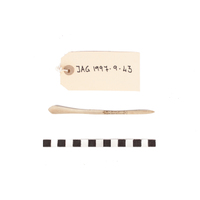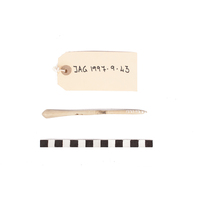Metadata
Spoon
[ Source of title : FHYA using JAG materials ]
Object
1997-9-43
Creative Commons License: CC BY-NC-ND https://creativecommons.org/licenses/by-nc-nd/4.0/
Description [Source - Nessa Leibhammer for FHYA, 2017, using JAG materials: Spoon, Zulu; Material: Bone, pigment]
Acquisition [Source - Nessa Leibhammer for FHYA, 2017: In the 1840s 50s and 60s, after British annexation of the area known as the Colony of Natal, some colonial writers referred to the inhabitants as Zulus because of their linguistic similarities to those who lived north of the Thukela in the Zulu Kingdom. This term obscured many fissures and differences of identity that existed at the time. Towards the end of the 19th century the notion of sameness strengthened in local African communities in opposition to colonial oppression (Wright in Tribing and Untribing the Archive 2016, pp. 202, 212, 213, 214).]
Attributions and conjectures [Source - Nessa Leibhammer for FHYA, 2017: Comments on classification: In his 'A Preliminary Survey of the Bantu Tribes of South Africa', Union of South Africa, Department of Native Affairs, Ethnological Publications, Vol. 5, Pretoria, Government Printer, (1935): 7, 70-83, national government ethnologist, Nicholas Van Warmelo did not use the term "North Nguni". He grouped people living both north and south of the Thukela, under one umbrella term, "Natal Nguni", based on linguistic affinity. His classification was adapted by the ethnology curator, Margaret Shaw, in her 1958 "System of Cataloguing Ethnographic Material in Museums" which determined that items from the region were to be classified as "Natal Nguni: Zulu and others (not differentiated)." According to art historian, Anitra Nettleton, the classificatory system used by art galleries and museum shifted from Shaw's model to the one where "Natal Nguni" fell away and was replaced by "North/Northern Nguni" for KwaZulu-Natal and Swaziland because scholars found it difficult to distinguish items from adjacent areas, or emmigrant people from those from the KZN region. Scholars working with the JAG materials used broad ethno-linguistic categories (Zulu, Xhosa, Tsonga, Shona, Sotho, Tswana) to identify the makers/users of the objects, all of which came to JAG without much by way of provenance, and identification was based on factors such as object type, materials, formal composition, style and surface patterning (emails A. Nettleton to N. Leibhammer, 25 and 28 November 2014).]
| Event Actor | Event Type | Event Date | Event Description |
|---|---|---|---|
| Five Hundred Year Archive (FHYA) | Online curation | 2017 - | Digital image by Nessa Leibhammer |
| Johannesburg Art Gallery (JAG) | Custody | 1997 - | |
| Udo Horstmann | Collection | [19-?] | |
| No attribution | Making | YYYY |
If you have difficulty accessing the objects, use these links.


Contributions